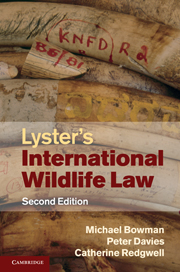Book contents
- Frontmatter
- Contents
- Foreword
- Preface
- List of abbreviations
- PART I Foundations of international wildlife law
- PART II Species regulation
- PART III Regional wildlife regulation
- 8 The Convention on Nature Protection and Wildlife Preservation in the Western Hemisphere
- 9 The African Convention on the Conservation of Nature and Natural Resources
- 10 The Convention on the Conservation of European Wildlife and Natural Habitats
- 11 Polar regions
- 12 Other regional and subregional arrangements
- PART IV Global wildlife regulation
- PART V Biological diversity: a new perspective on wildlife regulation
- PART VI Cross-sectoral issues in wildlife regulation
- PART VII Conclusion
- Index
- References
10 - The Convention on the Conservation of European Wildlife and Natural Habitats
Published online by Cambridge University Press: 05 July 2011
- Frontmatter
- Contents
- Foreword
- Preface
- List of abbreviations
- PART I Foundations of international wildlife law
- PART II Species regulation
- PART III Regional wildlife regulation
- 8 The Convention on Nature Protection and Wildlife Preservation in the Western Hemisphere
- 9 The African Convention on the Conservation of Nature and Natural Resources
- 10 The Convention on the Conservation of European Wildlife and Natural Habitats
- 11 Polar regions
- 12 Other regional and subregional arrangements
- PART IV Global wildlife regulation
- PART V Biological diversity: a new perspective on wildlife regulation
- PART VI Cross-sectoral issues in wildlife regulation
- PART VII Conclusion
- Index
- References
Summary
Background
In view of mounting political concern during the 1970s regarding the poor implementation of existing wildlife conventions in the region, the Committee of Ministers of the Council of Europe established a committee of experts to prepare a draft of a new treaty. The resulting Convention on the Conservation of European Wildlife and Natural Habitats was formally approved by the Committee of Ministers in June 1979 and opened for signature on 19 September in Bern. The Bern Convention came into force on 1 June 1982. By January 2010, there were fifty contracting parties in total, including the EU, four African countries, and all but two member states of the Council of Europe itself.
The aims of the Convention are to conserve wild flora and fauna and their natural habitats, to promote co-operation between countries in their conservation efforts and to give special attention to endangered and vulnerable species, including those that are migratory. Detailed provision is accordingly made for the conservation of wildlife and habitat generally and for the specific protection of species listed in Appendices I (strictly protected plants), II (strictly protected animals) and III (protected animals). Alongside the aesthetic, scientific, cultural, recreational and economic values of the wildlife heritage, the preamble recognises also its intrinsic value – the first such affirmation in a major wildlife treaty.
- Type
- Chapter
- Information
- Lyster's International Wildlife Law , pp. 297 - 345Publisher: Cambridge University PressPrint publication year: 2010
References
- 3
- Cited by



